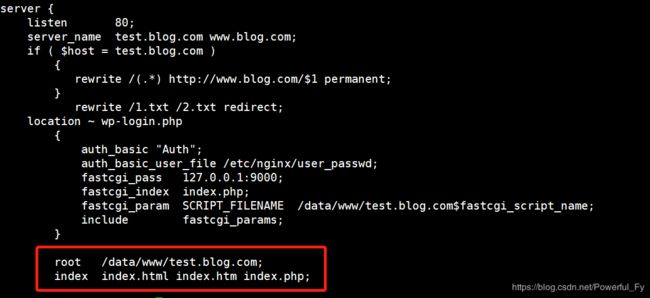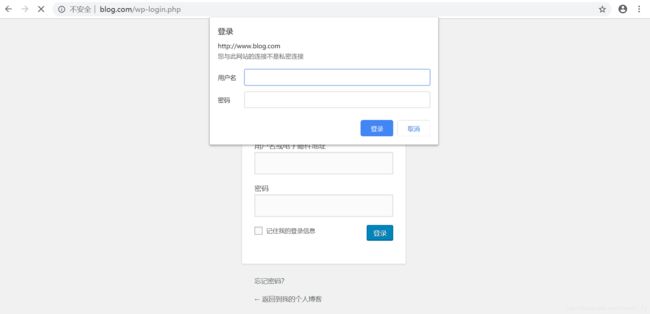Nginx配置双重用户认证/Nginx location优先级详解
Nginx双重用户认证:
适用于一些网站的重要页面(比如:管理员登录的后台管理页面),双重认证的效果就是在打开重要页面输入账号密码登录之前先验证一次用户双重认证的用户名和密码。
接下来以上一篇文章介绍的使用WordPress搭建个人博客网站为例进行配置nginx双重用户认证
打开个人博客网站管理员登录页面:

修改nginx虚拟主机配置文件给当前页面wp-login.php添加双重用户认证:
[root@linux ~]# vi /etc/nginx/conf.d/default.conf
添加以下内容:
location ~ wp-login.php
{
auth_basic "Auth";
auth_basic_user_file /etc/nginx/user_passwd;
fastcgi_pass 127.0.0.1:9000;
fastcgi_index index.php;
fastcgi_param SCRIPT_FILENAME /data/www/test.blog.com$fastcgi_script_name;
include fastcgi_params;
}
并将root、index项的location去掉,使之变为全局配置:

由于添加的配置内容定义了双重用户验证配置为/etc/ngninx/user_passwd,但当前没有这个文件,需要使用htpasswd命令生成该文件:
安装httpd-tools包:
[root@linux ~]# yum -y install httpd-tools
生成配置文件并添加认证用户:
[root@linux ~]# htpasswd -c /etc/nginx/user_passwd admin1
New password:
Re-type new password:
Adding password for user admin1
#生成user_passwd文件并增加认证用户admin1并设置密码,-c 参数:创建,首次生成认证配置文件使用
需要新增认证用户使用-m 参数(MD5加密):
[root@linux ~]# htpasswd -m /etc/nginx/user_passwd admin2
New password:
Re-type new password:
Adding password for user admin2
查看用户认证配置文件即可看到添加的用于认证账号:
[root@linux ~]# cat /etc/nginx/user_passwd
admin1:$apr1$Qn57LBlw$fE4QyHrsQReHUrSvPdmxs/
admin2:$apr1$VH2Qe1nW$zn.1Hzn3QaF2RwJJDheGN.
重载nginx:
[root@linux ~]# nginx -t
nginx: the configuration file /etc/nginx/nginx.conf syntax is ok
nginx: configuration file /etc/nginx/nginx.conf test is successful
[root@linux ~]# nginx -s reload
再次打开个人博客网站管理员登录页面即可显示双重用户认证对话框:

#先进行双重用户验证后即可输入管理员账号密码登录后台
Nginx location优先级详解:
nginx的location配置:
nginx location语法规则:location [=|~|~*|^~|/] /uri/ { … }
nginx的location匹配的变量是$uri
| 符号 | 说明 |
|---|---|
| = | 表示精确匹配 |
| ^~ | 表示uri以指定字符或字符串开头 |
| ~ | 表示区分大小写的正则匹配 |
| ~* | 表示不区分大小写的正则匹配 |
| / | 通用匹配,任何请求都会匹配到 |
优先级规则:
= 高于 ^~ 高于 ~* 等于 ~ 高于 /
规则示例:
location = “/12.jpg” { … }
如:
www.test.com/12.jpg 匹配
www.test/abc/12.jpg 不匹配
location ^~ “/abc/” { … }
如:
www.test/abc/123.html 匹配
www.test.com/a/abc/123.jpg 不匹配
location ~ “png” { … }
如:
www.test.com/aaa/bbb/ccc/123.png 匹配
www.test.com/aaa/png/123.html 匹配
location ~* “png” { … }
如:
www.test.com/aaa/bbb/ccc/123.PNG 匹配
www.test.com/aaa/png/123.html 匹配
location /admin/ { … }
如:
www.test.com/admin/aaa/1.php 匹配
www.test.com/123/admin/1.php 不匹配
对比 / 和 ~
示例1:
server{
listen 80;
server_name www.test.com;
root /tmp/123.com;
location /abc/
{
echo "/";
}
location ~ 'abc'
{
echo "~";
}
}
测试命令:curl -x127.0.0.1:80 ‘www.test.com/abc/1.png’
结果是:~
对比 ~ 和 ~*
示例2:
server
{
listen 80;
server_name www.test.com;
root /tmp/123.com;
location ~ 'abc'
{
echo '~';
}
location ~* 'abc'
{
echo '~*';
}
}
测试命令:curl -x127.0.0.1:80 ‘www.test.com/abc/123.html’
结果是:~
示例3:
server
{
listen 80;
server_name www.test.com;
root /tmp/123.com;
location ~* 'abc'
{
echo '~*';
}
location ~ 'abc'
{
echo '~';
}
}
测试命令:curl -x127.0.0.1:80 ‘www.test.com/abc/123.html’
结果是:~*
结论:~ 和 ~*优先级其实是一样的,如果两个同时满足条件,配置文件中哪个location靠前,哪个生效。
对比 ^~ 和 ~
示例4:
server
{
listen 80;
server_name www.test.com;
root /tmp/123.com;
location ~ '/abc'
{
echo '~';
}
location ^~ '/abc'
{
echo '^~';
}
}
测试命令:curl -x127.0.0.1:80 'www.test.com/abc/123.html
结果是:^~
对比 = 和 ^~
示例5:
server
{
listen 80;
server_name www.test.com;
root /tmp/123.com;
location ^~ '/abc.html'
{
echo '^~';
}
location = '/abc.html'
{
echo '=';
}
}
测试命令:curl -x127.0.0.1:80 'www.test.com/abc.html
结果是:=